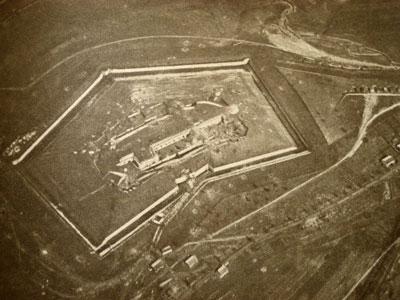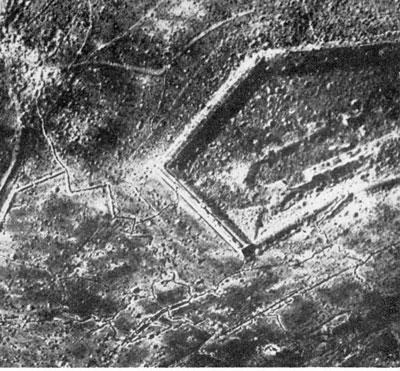
WWII: Maginot Line | Normandy | V-Weapon Sites | Arnhem
Further afield: Crete
| Home Tracing Military Ancestors Travel Advice CWGC Cemeteries Iron Harvest News Book Reviews Glossary Links Contact Me Verdun:
 
|
Location 6 – Fort Douaumont
Brief History - The Initial German Assault Directions – Return to the main road (the D905) and turn left to Vacherauville. In the centre of the village take a left on the D964 through Bras-sur-Meuse and take a left turning at the agricultural elevator (the D913b). This road runs to the south-east of the main front line during the summer fighting, the Côte de Froideterre ridge and some key locations which will be visited later in the tour. When you reach the huge National Cemetery, bear to the right and continue past the cemetery on the left. The road to Fort Douaumont is signposted to the right (the D913d). Practical Information – Along with the Ossuary this is probably the most-visited site on the battlefield, although on all visits I have conducted, there appears to be more than enough parking space. The visitor should allow at least an hour to properly explore this location as there is a small but very interesting museum just inside the entrance. The fort is closed in January and February but is open the rest of the year with a two-hour break for lunch outside the main summer months. The inside of the fort is very cool and damp which is a relief in the heat of the summer but it is advisable to wear something warm at other times of the year.
The following aerial photograph gives a good idea of the structure and layout of the fort prior to its battering by artillery. The façade of the barrack block and the merlon protruding from it are clearly discernible.
This picture was taken at the end of 1916 after the destruction wrought by the guns.
Historical Notes – Fort Douaumont was one of a series of forts designed in the wake of the Franco-Prussian War of 1870, by the great French fortress engineer, Séré de Rivières, to protect Verdun in the event of a future conflict. Located close to the highest point of the Hauts de Meuse, Douaumont was designed from the outset as the keystone of the Verdun defensive system on the east bank. However, improvements in the range and destructive power of artillery in the 1880's led to the fort being almost completely rebuilt shortly after it was completed. The original earth covering was removed and a layer of sand with a concrete overcoat was added to the exterior of the masonry and the earth then re-laid over the top. Extensive trials had shown that this layer of sand between the masonry and concrete would help absorb the shockwave of even the heaviest shells. Unfortunately, events early in the war where some of the Belgian forts were quickly breached by German heavy artillery, convinced French planners that the value of the Verdun forts in defending against any major German attack, was limited. Artillery was stripped from them for use elsewhere along the front and the garrisons reduced. It was largely due to this unpreparedness and the sudden collapse of the French front in this sector that led to patrols from the 24th Brandenburg Regiment capturing Douaumont on 25th February. Although stories persist that the French defenders mistook advanced German patrols for Zouaves (French colonial troops) and held their fire. The story of the fort's capture is, however, still shrouded in some mystery. Three German officers, Radtke, Haupt and Brandis, all claimed to have entered the fort first and taken the surrender of the garrison. Later, in the 1930's, another officer, the commander of the 2nd Battalion, 24th Brandenburgers, Major von Klüfer, suggested that it was a Sergeant Kunze who had first led a group into the fort, taking prisoner the crew of the 155mm gun. Whilst recent research has still provided no definitive answer, it does seem clear that both Radtke, leading a patrol from the east and Haupt, from the north, crossed the ditch and climbed the slope onto the top of the fort at roughly the same time. It was Haupt's men who located the French garrison of just 25 men, deep in the interior of the fort and accepted the surrender of its commander, Warrant Officer Chenot. Brandis and his group entered the fort about an hour later. It still seems incredible that such a keystone of the French defensive network could fall so easily to relatively lightly armed attackers. The capture of Douaumont caused euphoria in Germany and sent shock-waves through the French command who began to question whether the east bank could be held at all. Their answer was to recapture Douaumont as quickly as possible – a decision which was to dictate the course of the battle for the next eight months. In fact it was October 24th before the French, under General Mangin, retook the fort and then only after months of the bitterest fighting and slaughter on the Côte de Froideterre and amongst the woods and ravines between Douaumont and the Belleville Ridge. During this period the fort was struck by literally thousands of French shells turning the exterior into a jumble of concrete, masonry and pummelled earthworks. Ironically the worst loss of life occurred on 8th May 1916, when a stove ignited flame-throwers, grenades and shells in one of the magazines. The resulting explosion and fire killed 679 and wounded a further 1,800 German soldiers. A chapel was built after the war at the site of this terrible accident. |
||||||||


